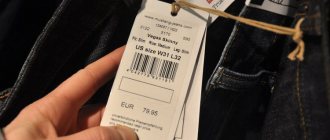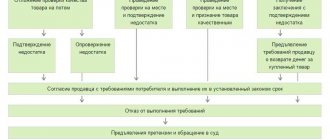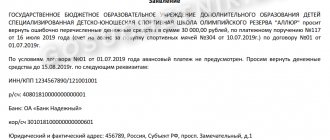Situations when consumers have to return an unsuitable product back to the store are extremely common. The item may not be the right size, may be uncomfortable, may simply not be liked, or may be defective.
In all these cases, if the two-week period after purchase has not expired, the labels and tags have not been cut off and there are documents confirming the transaction, the item can be returned. But what if the labels were cut off immediately after purchase? Is it possible to return/exchange an unsuccessful purchase in this situation?
The answers to this and many other questions about the return and exchange of non-food products are in this article.
Is it possible to return it legally?
The Law “On the Protection of Consumer Rights,” and specifically the 25th article of this law, states that the buyer has the right to return it within 14 days after purchasing the product (the day of purchase does not count) . The product must not be used by the consumer and must retain its original appearance.
For a legal return, the safety of all tags, labels, seals and labels is required. Thus, if there is no label or tag on the item being returned, or it is there but cut off, the seller can legally refuse to return the customer, citing a violation of the original appearance of the product.
As for checks and receipts, their availability is not so important for the return of quality goods. A desirable, but not mandatory, condition for exchange/return is the presence of a cash receipt, sales receipt, and warranty certificate. These three documents are interchangeable, and in order to painlessly return an unsuitable item to the store, it is enough to have at least one of the three documents. However, even if all three are lost, witness testimony can serve as evidence of the completion of the act of sale and purchase.
Thus, if a quality product has not been used while at the client’s home, the client can return it within two weeks after purchase only if the original appearance is preserved and all labels are present. But if we are talking about low-quality (defective, defective goods), then different laws apply here.
The “Consumer Rights Protection Law” allows items with defects to be returned to the store during the entire warranty period of the purchase, even if these items have been used and have traces of use. That is, even if the tags, labels and seals are removed from them. In this case, the main thing will be the presence of a warranty card for the product and expert confirmation that the product defect is really a consequence of a manufacturing defect.
If a warranty period has not been established for a specific product, the default warranty is 2 years or 24 months.
Is it possible to return or exchange an item without a label?
Based on Article 25 of the Law of the Russian Federation dated 02/07/1992 No. 2300-1 “On the Protection of Consumer Rights” , a quality product that is not suitable for objective reasons can be exchanged if the following requirements are met:
- the product was not used (not worn, not used);
- the original appearance and properties have been preserved, including seals and factory labels;
- there is a document confirming payment;
- the product does not belong to the category of products that cannot be returned (List approved by the Decree of the Government of the Russian Federation of January 19, 1998);
- The product does not apply to food products.
What are seals and factory labels:
- Factory labels are a manufacturer's label, usually sewn onto the product itself or sewn into a seam and containing information about the product name, article number, grade, fabric composition, care conditions, size, etc.
- Point of sale labels are price tags, they usually duplicate information from the factory label, plus price and information about discounts, store address, etc.
- Seals are fabric, plastic, or metal means of attaching labels to the clothing itself (ribbons, ropes, plastic or metal clips).
The law does not clearly define what form the tag should be in. But the main thing is that it should be.
It’s one thing if a leather tag, for example on jeans, or a fabric tag sewn into the seam of a down jacket is cut off, then there is a loss of presentation and the seller has every right to refuse to accept such an item. Because It will be very difficult for another client to implement it.
And if hanging tags and price tags are cut off but kept, what should you do? In this case, everything depends on the seller, on his loyalty. Has the right to refuse a return, but can also change it.
It should be taken into account that many items in stores are sold with tags torn off or damaged .
You need to try to negotiate with the seller, emphasizing that the product has retained all its properties, only the price tags have been cut off. If the seller is still against the exchange, you can go to court.
It turns out that according to the law, without question, the seller is obliged to exchange the goods if all tags are retained on the goods . The remaining options are controversial and depend on the flexibility of the store.
If the product is of poor quality or defective, then the requirement for tags and labels is no longer required. This is a completely different return scheme.
Do I need a receipt when returning a purchase?
Essentially, a receipt is proof of the transfer of money for a purchase. The most advantageous option is when it is in hand (cash or sales receipt, or electronic receipt). The tags are attached, the receipt is available - the seller is obliged to exchange the goods.
If there is no check, then the buyer can refer to the testimony of witnesses . It’s also possible that the seller or cashier who served you will remember you and this will serve as proof of payment. It is possible to seek help from the security service of the retail outlet and view video recordings from surveillance cameras, which show the transfer of money in a particular store from this particular buyer.
Thus, the absence of a receipt is not critical. There are many ways to prove the transfer of money from the buyer to the seller.
Which products can be returned and which cannot?
According to the laws of the Russian Federation, not every product can be returned back to the store, even if the requirements described above are met (observing a two-week period after purchase and maintaining its original appearance). Thus, at the end of the last century, the Russian Government officially approved a list of goods that cannot be returned to the store because they “didn’t like” or “didn’t fit.”
These products include:
- Food;
- medications;
- cosmetics;
- personal hygiene products;
- household chemicals;
- building materials;
- printing;
- weapons and cars;
- plants and animals;
- technically complex products.
The last category is veiled household appliances, as well as all sorts of modern devices such as smartphones, tablets, laptops, stereo and video systems, and similar equipment.
That is, if everything is fine with one of the above-mentioned goods, but it is inconvenient or the buyer does not like it, and the buyer wants to return it to the store, the store will most likely refuse such a request. And he will be right.
However, if the client finds even the slightest defect in the operation of the device (for example, the button does not work, the charge runs out too quickly, etc.) within 15 days after purchase, even an item from the list prohibited for return can be legally and quickly returned (even without an examination ) as defective, or exchange for a similar working one.
If a defect is discovered two weeks after purchase, but the warranty has not expired, the product can also be returned/exchanged/repaired free of charge under warranty. However, in this case, you will definitely need to draw up a special document - a claim - and obtain an expert opinion that the product is truly defective and not damaged by the user.
How to return an item
Actually, the algorithm of actions is simple:
1. We take the item and go to the store.
We explain what’s what and state one of the requirements described above. We find out whether the seller is ready to fulfill it voluntarily. If you agree, we issue a refund and rejoice! If he refuses, go to step No. 2.
2. We are writing a complaint.
We briefly outline the essence of what happened and demand that the consumer’s rights be fulfilled in writing.
Claim for return of goods of inadequate quality
We hand it over to the seller against signature or send it by registered mail if they refuse to accept it from hand to hand.
3. Waiting for a response.
If the seller agrees to settle everything voluntarily, he will contact you and offer to visit the store on the agreed day and time. If you do not agree, you will draw up and send a written response. In the second case, there is no point in arguing - we will complain.
Return and exchange procedure
So, we found out that it is impossible to return a high-quality product (goods of proper quality) that have not retained their original appearance - lost tags, fairly worn - even if the two-week period after purchase is observed and receipts are available.
If the product is defective (poor quality), it can be returned even without labels and seals, and even if it has obviously been used. The client's procedure in this case should be as follows. First of all, you need to draw up a special document - a claim or application for the return of goods. This paper is drawn up in any form, can be handwritten or printed, but must contain the following information:
- personal data of the client;
- store details;
- data on when, where and by whom the goods were purchased;
- information about where, when and by whom the defect was discovered;
- the customer’s request is to return or replace the product;
- date and client signature with transcript.
Next, you should prepare the necessary documents and make three copies of them. You will need documents such as:
- receipts (cash and sales receipts);
- warranty card with a corresponding note about the purchase;
- return application or claim;
- passport.
Then, with the defective product, a set of all the listed papers and an attitude towards a positive outcome, you can safely go to the store. There, the manager or manager of the enterprise needs to describe the situation and hand over the claim against signature.
By law, within three days from the receipt of the claim and the goods, the seller must give the client a response. If the seller insists on an examination, the store must provide a response along with an expert opinion within 10 days. And then there may be several options for the development of events:
- the examination finds a defect, and the store fully satisfies the client’s requirements;
- the examination finds traces of improper use, and the seller refuses the client, moreover, the client covers the costs of the examination;
- the examination finds a defect, and the seller guarantees the repair of the product (in the case of a used product under warranty).
If the buyer does not agree with the seller’s answer, he has the right to initiate a re-examination or go to court and defend his rights there.
When can I return it or choose something else?
The legislation establishes several types of deadlines regarding the return of goods:
- return within 14 days of quality goods;
- return within the warranty period, but not more than two years from the date of purchase of the defective product.
If the product is of high quality
The buyer has 14 days to return the item, starting from the day following the date of purchase.
If the seller agrees to return the goods, then:
- exchange for a similar model;
- refund of the paid amount (within 3 days).
Products can be exchanged either every second or later. For example, if a certain item is currently out of stock in a store, the customer will have to wait until the item goes on sale.
If the purchase was made in an online store, then the period is not 14 days, but 7. If the seller did not inform the buyer about this period, then the period is extended by 3 months. The period is calculated from the moment the goods are received from the supplier.
If the product is defective
Products with defects can be returned during the warranty period . In this case, you must have a warranty card on hand.
There are some peculiarities here:
- There are seasonal warranty periods. In this case, the period is calculated from the start of the season.
- If there is no deadline on the coupon or on the packaging, then it is considered not established. And in this case it is equal to 2 years. The period is calculated from the date of purchase.
- In the case of online purchases, the period is counted from the day the goods are handed over to the buyer.
Regardless of whether a quality or defective product is exchanged, the replacement must be made within 7 days from the date of presentation of the request. If additional verification of the goods (examination) is needed, then within 20 days (Article 21 of the Law).
When a controversial situation may arise and what to do
In fact, a huge number of controversial situations arise every day when returning or exchanging goods. And this is not surprising - he defends his interests and does not want to lose money. Let's look at the most common disputes when returning.
The seller does not accept the claim
Very often, the problem arises at the very first stage of interaction with the seller on the issue of return: after listening to the client, the seller does not agree with any of his demands, moreover, he does not want to accept the claim.
In this case, lawyers advise resorting to postal services - sending a claim to the seller by registered mail. Upon receipt, he will be required to sign the document and subsequently in court the seller will no longer be able to deny the existence of the claim.
The seller refused the claim
Another common situation is when the seller, having received a claim, not even wanting to conduct an examination, responds to the client’s application with a refusal. In this case, the client has the right to disagree with the store’s response, independently initiate an examination and, based on its results, sue the store.
If the buyer wins the case, all legal costs, as well as examination costs, will have to be paid by the store.
The seller insists on an exchange, not a refund
One of the most common situations is when the seller, not wanting to lose his money, but also not wanting to take the matter to court, agrees to exchange the defective product for a working one, but still refuses to return the money. In this case, the buyer can agree and compromise, or he can continue to fight for his rights, calling on justice for help.
The seller does not change the product for a long time
If the parties agreed that the product will be replaced, but after the expiration of the 10-day period the seller has not provided the client with a worthy replacement, citing the fact that the required model is not in the store, the client has the right to demand monetary compensation - the full amount of the cost of the product.
The seller is delaying repairs
You can legally demand money for a product (full refund) even if the product is repaired under warranty for longer than 45 days, or if immediately after the warranty repair, less than a month later, the product deteriorates again.
Useful tips for everyone
Hello, dear blog readers! In today's article I wanted to talk about whether it is possible to exchange a product if you don't like it or don't like it. Let's look at one story.
The guy bought his wife a dress, but she didn’t like it. Is it possible to return clothes now, within what time frame, and what to do when the store does not accept a claim?
The consumer has the right to exchange a non-food product of proper quality for a similar product if it does not suit the style, color, size, dimensions or configuration.
(Art. 25 of the Law “On Protection of Consumer Rights” )
But this right does not apply to all things. As for clothing, this list includes only hosiery and lingerie; your dress can be returned.
The list of quality goods that are not subject to exchange or return was approved by Decree of the Government of the Russian Federation No. 55 of January 19, 1998 .
You can exchange an item that does not fit or return it within fourteen days, not counting the day of purchase. Usually the store will accommodate you and exchange at a later date. If the seller does not agree to return the money, citing the expiration of two weeks, try to persuade him to at least exchange the unsuitable dress for something, perhaps for a more expensive item with an additional payment.
If the seller is stubborn and does not want to accept or exchange the goods within these two weeks from the date of purchase, he will have to “tighten measures.” We take and write the claim in two copies. (An example of a claim is given below)
How to properly submit a claim? There are two options. Go to the store yourself and give the person in charge or any seller one copy of the application. To prove that the application was accepted, ask for a signature, date and incoming registration number on your copy of the application.
Second option. If you don’t have the opportunity to go and submit the claim yourself, or you don’t want to waste your precious time at all, you can use the mail. We send the claim by registered mail with acknowledgment of receipt to the legal address of the store that sold the goods. Once your claim is served on the recipient, he or she will sign the notice and the notice will be mailed back to you as proof of service (in case of litigation).
In any case, there is nothing to be afraid of, the claim is not addressed to the seller who took your money. You are writing a complaint against the main person of the store, and you don’t need to know his last name, so in the “to” line we simply write: Store Director. And here is a sample application.
To the director of LLC “Bad Firm” Volgograd region, Uryupinsk, st. Bepredelnaya, 13 (indicate the full name of the performer and his address) from Righteous Ivan Ivanovich, residing at the address: Uryupinsk, st. Pravovaya, 33, apt. 15 tel. 351-00-00 (indicate your last name, first name, patronymic and address)
STATEMENT
On August 8, 2011, I purchased a women’s dress (specify model) in your store for my wife, which is confirmed by a cash receipt (specify what documents confirm the purchase). After the purchase, I discovered that the dress does not fit________ (in size, style, color, shape, dimensions or configuration - indicate by what criteria the product does not fit).
The product has not been used, its presentation, consumer properties, seals, and factory labels have been preserved. The 14-day period from the date of purchase has not yet expired.
Please exchange the dress that doesn’t suit her for a similar, commercially available dress (specify model). If there is a difference in price, please make the necessary recalculation.
(If a suitable product is not available for sale, indicate this and demand a refund of the amount paid for the product within three days from the date of return of the specified dress.)
Attachment: sales and/or cash receipt
_____________signature
August 16, 2011
That’s all for today, until the next meeting, good luck in defending your rights and be healthy!
Where to complain about seller violations
If a seller openly violates the law “On the Protection of Consumer Rights”, infringes on human rights, and causes material and moral damage, the actions of such a seller should not be left unpunished. resolve all controversial issues, defend your rights and return your hard-earned money .
.doc
If the buyer is confident that he is right, has a good evidence base (all documents are in order and available), with a 99% probability he will win the case and also receive moral compensation.
Another authority that is a priori on the consumer’s side is Rospotrebnadzor . He has the right to inspect enterprises and, if violations are detected, impose large fines. Therefore, you can also call on Rospotrebnadzor specialists for help.








